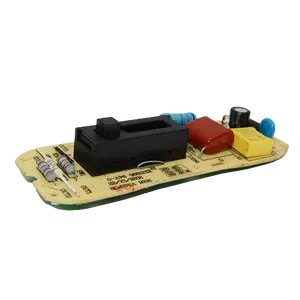(23625 products available)






























































































































































































































LED control circuits are essential for managing the behavior and performance of light-emitting diodes (LEDs). These control circuits can regulate the power supplied to LEDs, control their brightness, color, and on/off status. Below are the different types of LED control circuits:
Resistor Control Circuit
This is the simplest way to control an LED. It uses a resistor in series with the LED to limit current flow. The resistor value can be calculated using Ohm's law. This method is suitable for basic LED applications where the LED does not require precise control.
Transistor Control Circuit
This control method utilizes a transistor to switch the LED on and off or control its brightness. A small current at the base of the transistor (for a BJT) or a voltage at its gate (for a MOSFET) can control a larger current flowing through the LED. This method is suitable for applications where the LED needs to be controlled by a microcontroller or other low-power control signals.
PWM Control Circuit
Pulse Width Modulation (PWM) is a technique used to control the brightness of LEDs by changing the duty cycle of a digital signal. The LED is connected to a PWM signal from a microcontroller. The LED appears brighter when the signal is high for a more extended period and dimmer when it is high for a shorter period. This method is prevalent in dimmable LED lights and displays.
Analog Control Circuit
This control circuit allows brightness control by applying varying voltage levels. A potentiometer or variable resistor can be used to change the voltage sent to the LED, controlling its brightness. This method is suitable for applications where simple analog control is sufficient.
Microcontroller-based Control Circuit
In this control circuit, a microcontroller controls the LED directly. The microcontroller can be programmed to control the LED in various ways, including changing brightness levels, color mixing (for RGB LEDs), and on/off scheduling. This method is suitable for complex LED applications that require intelligent control, like LED displays and decorative lighting.
LED Driver Circuit
These are dedicated ICs or circuits designed to control LEDs, especially high-power ones. They provide constant current output to the LEDs, ensuring consistent brightness and preventing damage due to excessive current. LED driver circuits come in various types, such as boost, buck, and buck-boost converters, depending on the application requirements.
LED control circuit comes with many features. Here are some of them, along with their functions.
Functions
Features
There are various applications of LED control circuits in different industries and sectors. Some of them include:
When selecting LED control circuits for purchase, buyers should consider several factors to ensure they meet the needs of their intended application. Here are some key factors to consider:
Application Requirements
Buyers should begin by assessing the specific requirements of their application. For instance, if it is for use in a simple LED lighting circuit or a complex display. They should also consider the number of LEDs, control methods, and power requirements.
Control Method
LED control circuits can be controlled through various methods. Buyers should determine the appropriate method for their needs. For example, control methods include: analog circuits, digital circuits, and microcontroller-based circuits.
Power Requirements
Different LED control circuits have different power requirements. Buyers should ensure that the power supply can handle the required voltage and current. Also, they should consider the power efficiency of the circuit. Selecting a circuit with high power efficiency reduces energy consumption and heat dissipation. This is especially important in battery-powered or eco-friendly applications.
Scalability and Flexibility
Depending on the application, buyers can choose a scalable and flexible LED control circuit. This allows the circuit to accommodate future expansion and modifications. The circuit should control various types and numbers of LEDs.
Quality and Reliability
Business owners should buy LED control circuits from reputable manufacturers. They should check the reviews and the manufacturers' quality certifications. This ensures that the circuits are reliable and of good quality. They should also consider the durability of the circuit, especially if it will be used in harsh environments.
Technical Support and Documentation
LED control circuits come with technical documentation and support. Business owners should consider the availability of technical support and the quality of the documentation. This can be important when faced with technical issues during the circuit's operation.
Q1: What are control LED lighting circuits?
A1: Control LED lighting circuits are electrical circuits designed to power and control LED lights. They can be simple circuits that light up the LEDs with a power source or more complex ones that control the brightness and color of the LEDs. The circuit usually consists of a resistor and an LED.
Q2: Do LEDs require control circuitry?
A2: Yes, LED lights require control circuitry to ensure they are powered at the appropriate voltage and current levels. The LED control circuitry can also provide features like dimming, color control, and smart control integration.
Q3: What are LED control circuit components?
A3: The control LED lighting circuit components include microcontrollers, resistors, transistors, MOSFETs, PWM signals, and in some cases, specialized LED driver ICs. For RGB LEDs, additional components like transistors or MOSFETs are used to control each color channel.
Q4: How can someone control an LED light with a switch?
A4: To control an LED light with a switch, connect the LED to the switch and a power source. The circuit path will have to include a resistor to prevent excess current that may damage the LED. When the switch is turned on, the LED will light up. If it is connected to more LEDs, they can light up in different colors.
Q5: How can someone control the brightness of an LED light?
A5: To control the brightness of an LED light, connect the LED to a power source using a transistor and a variable resistor. The variable resistor can be part of a potentiometer whose resistance is varied to control the brightness of the LED. The brightness is directly proportional to the amount of current flowing through the LED.